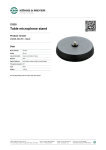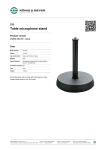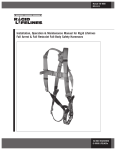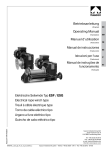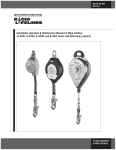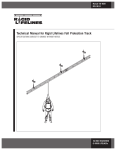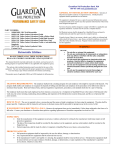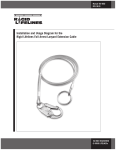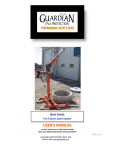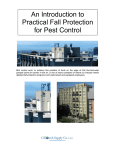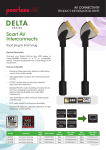Download Connex™ Shock Absorbing Lanyards User Manual
Transcript
User Instruction Manual Rigid Lifelines® Connex™ Shock Absorbing Lanyards (SALs) Part Numbers: RL-3118(6); RL-3119(6); RL-3128(12); RL-3128(6); RL-3129(6); RL-30198(6); RL-30199(6); RL-30298(12); RL-30298(6); RL-30299(6) ISO 9001: 2008 Registered Manual 103-0057 General Safety Information Under Penalty of Law This User Instruction Manual is not to be removed except by the user of this equipment. ■ Current User Instruction Manuals must always be available to the user. ■ Read and understand these instructions before using equipment. ■ Do not throw away these instructions. ■ Misuse or failure to follow warnings and instructions may result in serious personal injury or death. Users must read and understand the User Instruction Manual provided with the product and be properly trained by their employer prior to use per OSHA 29 CFR 1910.66 and 1926.503 or applicable local standards. Compliant fall protection and emergency rescue systems help prevent serious injury during fall arrest. For instructions about proper use, refer to supervisor, User Instruction Manual, or call Rigid Lifelines at: 844-467-4443. Rigid Lifelines® Connex™ Shock Absorbing Lanyards (SALs) Manual 844-467-4443 2 Purpose Rigid Lifelines® Connex™ Shock Absorbing Lanyards are designed to be used as part of a personal fall arrest system to help limit the forces associated with fall arrest in the event of a fall. Fall Arrest System Components System Components Overview A complete fall arrest system consists of the following components: Anchorage, Body Support, and Connecting Devices. Note: For continuous protection, more than one system may be needed. Anchorage OSHA 29 CFR 1926.502 states that an anchorage, “Shall be independent of any anchorage being used to support or suspend platforms and capable of supporting at least 5,000 pounds (22.2 kN) per employee attached, or shall be designed, installed, and used as follows: as part of a complete personal fall arrest system which maintains a safety factor of at least two; and under the supervision of a qualified person.” Body Support A body support is the component of a personal fall arrest system that is worn on or around the body. Per OSHA 29 CFR 1926.502 (effective January 1, 1998), body belts are not acceptable* as part of a personal fall arrest system. Full body harnesses must be used for all fall arrest systems. *Note: The use of a body belt is acceptable in a positioning device system. Connecting Devices A connecting device is the link between the body support and anchorage. Connecting devices will vary depending on the application. 3 Rigid Lifelines® Connex™ Shock Absorbing Lanyards (SALs) Manual 844-467-4443 Table of Contents General Safety Information Purpose Fall Arrest System Components Instructions for Use Limitations for Use Anchorage Requirements Connection Compatibility Limitations Clearance Requirements Swing Fall Operation Performance Materials Training Inspection Frequency Cleaning, Maintenance, and Storage Labeling Inspection Log Sample 5-Year Inspection Grid Service Policy Warranty Rigid Lifelines® Connex™ Shock Absorbing Lanyards (SALs) Manual 844-467-4443 2 3 3 5 6 7 8 9 11 12 14 14 14 14 15 17 18 20 20 23 Back Cover 4 Instructions for Use Do not wrap the Connex™ Shock Absorbing Lanyards around any structure and connect the lanyard back onto itself, unless the lanyard has been specifically designed to do so. ■ Striking objects horizontally due to the pendulum effect of a swing fall may cause serious injury or death. ■ Always attach an unused lanyard to a lanyard storage keeper when not in use. Never attach the unused leg of the lanyard to the harness at any other location. ■ The regulations included herein are for reference only. They are not all-inclusive and not intended to replace a Competent Person’s judgement or knowledge of federal or state standards. ■ The analysis of the workplace must anticipate where workers will be performing tasks, the routes they will take to reach their tasks, and the potential/existing exposure to fall hazards. ■ Fall protection equipment must be chosen by a Competent Person. Selections must account for all potential hazardous workplace conditions. ■ All fall protection equipment should be purchased in a new and unused condition. ■ Select and install fall protection systems under the supervision of a Competent Person. Fall protection systems must be used in a compliant manner. ■ Fall protection systems must be designed in compliance with all federal, state, and local safety regulations. ■ Forces applied to anchors must be calculated by a Competent Person. ■ Harnesses and connectors selected must be compliant with manufacturer’s instructions and must be of compatible size and configuration. ■ A pre-planned rescue procedure is required as part of a complete fall protection program. The rescue plan must be project specific. The rescue plan must either allow for employees to rescue themselves or provide an alternative means for their prompt rescue. Store rescue equipment in an easily accessible and clearly marked area. ■ A Competent Person must train Authorized Persons to correctly erect, disassemble, inspect, maintain, store, and use equipment. Training must include the correct use of personal fall arrest systems, the ability to recognize fall hazards, and how to reduce the dangers of fall hazards. ■ NEVER use any fall protection equipment to hang, lift, support, or hoist tools or equipment unless that equipment is explicitly certified for such use. ■ Equipment must be inspected by a Competent Person at least every six months. These inspections must be documented in equipment instruction manual and on equipment inspection grid label. ■ 5 Rigid Lifelines® Connex™ Shock Absorbing Lanyards (SALs) Manual 844-467-4443 Equipment must be inspected for defects including (but not limited to): the absence of required labels or markings, improper form/fit/function, evidence of cracks, sharp edges, deformation, corrosion, excessive heating, alteration, excessive wear, fraying, knotting, abrasion, and absence of parts. Equipment that fails inspection in any way must immediately be removed from use or repaired by an entity approved by Rigid Lifelines. ■ Physical harm may still occur even if fall safety equipment functions correctly. ■ Sustained post-fall suspension may result in serious injury or death. Use Rigid Lifelines® Trauma Relief Pack (RL-TRP) to reduce the effects of suspension trauma. The RL-TRP is available for use on all Rigid Lifelines Full Body Harnesses. The RL-TRP must be choked onto the harness vertical torso straps located above the primary connection opening of the hip joint. Refer to the RL-TRP User Instruction Manual for more information. ■ Limitations for Use Connex™ Shock Absorbing Lanyards marked “ANSI Z359.1” require space for up to 6 feet of free fall with a maximum capacity up to 310 lb. (141 kg) including clothing, tools, etc. ■ Connex Shock Absorbing Lanyards marked “ANSI Z359.13” and “6ft. Maximum Free Fall” are designed for up to 6-foot free fall applications with a maximum capacity up to 310 lb. (141 kg) including clothing, tools, etc. ■ Connex Shock Absorbing Lanyards marked “ANSI Z359.13” and “12ft. Maximum Free Fall” are designed for up to 12-foot free fall applications with a capacity up to 310 lb. (141 kg) including clothing, tools, etc. ■ Connex Shock Absorbing Lanyards must be used with a full body harness. ■ Connex Shock Absorbing Lanyards are designed for a single user. ■ Unless explicitly stated otherwise, the maximum allowable free fall distance for lanyards must not exceed 6 feet. Shock absorbing lanyards marked “ANSI Z359.13” and “12ft. Maximum Free Fall” are designed for up to 12-foot free fall applications with a capacity up to 310 lb. (141 kg) including clothing, tools, etc. ■ Do not repair equipment on-site unless explicitly permitted by Rigid Lifelines. ■ Snap hooks, carabiners, and other connectors must be selected and applied in a compatible fashion. All risk of disengagement must be eliminated. All snap hooks and carabiners must be self-locking and self-closing and must never be connected to each other. ■ Age, fitness, and health conditions can seriously affect the worker in the event of a fall. ■ Consult a doctor if there is any reason to doubt a user’s ability to set up the equipment or withstand and safely absorb fall arrest forces. ■ Allowable range of individual worker weight limit (including all equipment) is 130-310 lb. unless explicitly stated otherwise. ■ Rigid Lifelines® Connex™ Shock Absorbing Lanyards (SALs) Manual 844-467-4443 6 Anchorage Requirements Anchorages All anchorages to which the Personal Shock Absorbers and Shock Absorbing Lanyards attach must meet the requirements of OSHA 29 CFR 1910.66 and ANSI Z359.1-2007. OSHA states: Anchorages to which personal fall arrest equipment is attached shall be capable of supporting at least 5,000 pounds (22.2 kN) per employee attached, or shall be designed, installed, and used as part of a complete personal fall arrest system which maintains a safety factor of at least two, under the supervision of a qualified person. ANSI Z359.1-2007 states that anchorages in a personal fall arrest system must have a strength capable of sustaining static loads, applied in all permitted directions by the system, of at least: (a) Two (2) times the maximum arresting force permitted on the system when certification exists; or (b) 5,000 pounds (22.2 kN) in the absence of certification. The strength in (a) and (b) must be multiplied by the number of personal fall arrest systems attached to the anchorage when more than one personal fall arrest system is attached to the anchorage. Anchorages should be located as vertically as possible above the user’s head and be positioned as not to exceed the maximum allowable free fall for the system. Anchorage Connectors Anchorage connectors are components that couple the personal fall arrest system to the anchorage. In accordance with ANSI Z359.1-2007, the anchorage connector must be capable of withstanding (without breaking) a 5,000 lb. (22.2 kN) load and the anchorage must be able to withstand a 3,600 lb. (16 kN) load without cracking or permanent deformation visible to the unaided eye. The strength of all anchorage connectors must be multiplied by the maximum number of personal fall arrest systems attached. A mobile anchorage connector should be used to provide lateral mobility and help prevent the possibility of a swing fall. Rigid Lifelines® Connex™ Shock Absorbing Lanyards have a minimum breaking strength of 5,000 lb. (22.2kN) when used as directed in the User Instruction Manuals. 7 Rigid Lifelines® Connex™ Shock Absorbing Lanyards (SALs) Manual 844-467-4443 If a shock absorbing lanyard is used with a cross-arm anchorage connector, other anchorage extension, horizontal lifeline, or extended D-ring, the additional length provided by these components must be taken into consideration during the clearance calculation process. Snap Hooks and Carabiners Snap hooks and carabiners used on Connex™ Shock Absorbing Lanyards marked with the “ANSI Z359.1-07” or “ANSI Z359.12-09” standard are self-locking with minimal tensile break strength of 5,000 lb. and a 3,600 lb. gate rating. Shock absorbing lanyards marked with the ANSI Z359.1-1999 standard incorporate self-locking snap hooks and carabiners with minimal tensile break strength of 5,000 lb., a minimum gate rating of 220 lb., and a minimum side load gate rating of 350 lb. Connection Compatibility Limitations All Rigid Lifelines equipment must be coupled to compatible connectors. OSHA 29 CFR 1926.502 prohibits snap hooks from being engaged to certain objects unless two requirements are met: 1. It must be a locking type snap hook. 2. It must be “designed for” making such a connection. a. “Designed for” means that the manufacturer of the snap hook specifically created the snap hook to be used to connect to the equipment in question. The following conditions can result in rollout* when a non-locking snap hook is used. Avoid the following connections: ■ ■ ■ ■ ■ ■ Direct connection of a snap hook to horizontal lifeline. Two (or more) snap hooks connected to one D-ring. Two snap hooks connected to each other. A snap hook connected back on its integral lanyard. A snap hook connected to a webbing loop or webbing lanyard. Improper dimensions of the D-ring, rebar, or other connection point in relation to the snap hook dimensions that would allow the snap hook keeper to be depressed by a turning motion of the snap hook. Rigid Lifelines® Connex™ Shock Absorbing Lanyards (SALs) Manual 844-467-4443 8 * Rollout: A process by which a snap hook or carabiner unintentionally disengages from another connector or object to which it is coupled. (ANSI Z359.0-2007) Clearance Requirements These illustrations are an example of how to calculate fall clearance when using a self-retracting lanyard or a shock absorbing lanyard. Image 1 shows a self-retracting lanyard anchored overhead with the other end connected to the dorsal D-ring of a full body harness. When positioning a selfretracting lanyard, include the following distances in your calculations: Using the Rigid Lifelines® Defy™ Self-Retracting Lanyard will require a total fall clearance of approximately 7.5 feet (2.3 meters) as measured from the working level to the nearest obstruction below. The total fall clearance combines the sum of the maximum allowable fall arrest distance of 54 inches or 4.5 feet (1.4 meters) and the safety factor of 3 feet (0.9 meters). 9 Rigid Lifelines® Connex™ Shock Absorbing Lanyards (SALs) Manual 844-467-4443 Image 2 shows a shock absorbing lanyard anchored overhead with the other end connected to the dorsal D-ring of a full body harness. Note that the length of your shock absorbing lanyard in relation to where it is attached is directly related to the amount of fall clearance that you will need. When using a shock absorbing lanyard, include the following distances in your calculations: Using the 6-Foot Connex™ Shock Absorbing Lanyard will require a total fall clearance of approximately 18 feet (5.5 meters) as measured from the anchorage point of lanyard to the nearest obstruction below. The total fall clearance combines the sum of the length of the lanyard, the maximum elongation of the lanyard (4 feet or 1.2 meters), the average distance between the worker’s dorsal D-ring (5 feet or 1.5 meters), and the safety factor (3 feet or 0.9 meters). Using an extended free fall (12 foot) Connex Shock Absorbing Lanyard will require a total fall clearance of approximately 20 feet (6.1 meters) when anchored at foot level and measured from the anchorage point of lanyard to the nearest obstruction below. The total fall clearance combines the sum of the length of the lanyard, free fall distance, the maximum elongation of the lanyard (5 feet or 1.5 meters), the average distance between the worker’s dorsal D-ring, (5 feet or 1.5 meters), and the safety factor (3 feet or 0.9 meters). Rigid Lifelines® Connex™ Shock Absorbing Lanyards (SALs) Manual 844-467-4443 10 Swing Fall To minimize the possibility of a swing fall, work as directly under the anchorage connector as possible. Striking objects horizontally, due to the pendulum effect, may cause serious injury. Swing falls also increase the vertical fall distance of a worker, compared to a fall directly below the anchorage connector. Swing falls may be reduced by using overhead anchorage connectors that move with the worker. Workers accessing areas greater than 30° off-plumb from overhead anchorage are at a higher risk for severe injury. Striking objects horizontally due to the pendulum effect of a swing fall may cause serious injury or death. 11 Rigid Lifelines® Connex™ Shock Absorbing Lanyards (SALs) Manual 844-467-4443 Operation Before Each Use Users of personal fall arrest systems must have a rescue plan in place if the users cannot rescue themselves or carry out the rescue. Connex™ Shock Absorbing Lanyards must be inspected prior to each use for wear, damage, and other deterioration. ■ All snap hooks and carabiners on product must be able to self-close and lock. ■ All webbing and rope must be inspected for tears, cuts, fraying, abrasion, discoloration, or other signs of wear and damage. Sewn terminations must be secure, complete, and not visibly damaged. All rope splices must be secure. ■ Cable must be inspected for kinks, broken strands, corrosion, abrasion, or other signs of wear and damage. ■ Swaged terminations must be secure with the thimble tight and not visibly damaged. ■ Load indicators must not be deployed. ■ Damaged and other deteriorated or defective components must be immediately removed from service in accordance with the requirements of OSHA 29 CFR 1910.66 & 1926.502. ■ Connecting Shock Absorbing Lanyards That Have a Shock-Pack Connex™ Shock Absorbing Lanyards with a shock-pack must be connected in a specific location. The shock absorbing end of the lanyard must connect to the dorsal D-ring of the full body harness. The opposite end of the lanyard is to be connected to the anchorage connector. Connecting Wrap-Around Shock Absorbing Lanyards Place the Rigid Lifelines Wrap-Around Shock Absorbing Lanyard over the qualified anchor and attach the non-shock absorbing end of the lanyard to the floating D-ring. Ensure that the webbing is not twisted around the anchor and adjust so the floating D-ring hangs below the anchor. Snap hook must not contact anchor. The shock absorbing end of the lanyard must be connected to the dorsal D-ring of the full body harness. Connecting Y-Lanyards Y-Lanyards are designed for single person use only. The shock absorbing end of the lanyard must be connected to the dorsal D-ring of the full body harness. Attach one leg of the Y-Lanyard to the anchorage connector and the unused lanyard leg to an approved lanyard storage keeper on the harness. Rigid Lifelines® Connex™ Shock Absorbing Lanyards (SALs) Manual 844-467-4443 12 Do not connect the shock absorbing end of the lanyard to any anchorage connector. Never attach the unused leg of the lanyard back to the harness at any location other than a lanyard storage keeper. When using Y-Lanyards to move between fall protection systems, attach the unused leg of the lanyard to the new location before disconnecting the first lanyard leg. Connection of both lanyard legs to separate anchorage connectors while transitioning between systems is acceptable. Connecting Personal Shock Absorbers Personal shock absorbers should be connected to the dorsal D-ring of the full body harness first, then connected to the rest of the fall arrest system Connecting to Fall Arresters Shock absorbing lanyards less than 3 feet in length may be attached to a fall arrester. Shock absorbing lanyards must be connected with the shock absorbing end of the lanyard connected to the dorsal D-ring of the full body harness. Shock absorbing lanyards must be connected to the dorsal D-ring of the full body harness first, then connected to a fall arrester. Fall arresters with permanently attached personal shock absorbers should first be connected directly to the dorsal D-ring of the full body harness. Ensure the vertical rope lifeline hangs freely from anchorage without twists or knots in the lifeline. With the arrow on the body of the fall arrester pointing up, insert the rope through the rope chamber. Unscrew the thumbscrew knob until the chamber opens. Insert the vertical lifeline rope into the chamber. The arrow on the body of the fall arrester must point up toward the 0221 vertical lifeline anchor point. Position the back half of chamber around the rope and close. Screw the thumbscrew into the receiving nut until the thumbscrew is tight. Secure the chamber by grasping the small knob on the security latch and moving it into position in the notch. Compress the fall arrester up to position on rope. 13 Rigid Lifelines® Connex™ Shock Absorbing Lanyards (SALs) Manual 844-467-4443 Performance 6-Foot Free Fall Connex™ Shock Absorbing Lanyards marked ANSI Z359.13-09 are rated for a 6-foot free fall and have an average arrest force of 900 pound force (4 kilonewtons) or less. When dynamically tested in accordance with the requirements of the ANSI Z359.13-09 standard, there is a maximum deployment distance of 42 inches (106.7 centimeters). 12-Foot Free Fall Connex Shock Absorbing Lanyards marked ANSI Z359.13-09 are rated for a 12-foot free fall and have an average arrest force of 1,350 pound force (6 kilonewtons) or less. When dynamically tested in accordance with the requirements of the ANSI Z359.13-09 standard, there is a maximum deployment distance of 60 inches (152.4 centimeters). Materials Webbing Rigid Lifelines® models use polyester webbing. Hardware Snap hooks and carabiners used on Connex Shock Absorbing Lanyards marked with the ANSI Z359.1-07 and ANSI Z359.12-09 standard are self-locking with a minimal tensile break strength of 5,000 lb. and a 3,600 lb. gate rating. Training Employers are responsible for providing training to any employee who may be exposed to fall hazards. Training will enable an employee to recognize and reduce fall hazards. Training must be conducted by a Competent or Qualified Person. Trainer and trainees must not be exposed to fall hazards during the training course. Inspection If inspection reveals any defect, inadequate maintenance, or unsafe condition, remove from service immediately. Rigid Lifelines® Connex™ Shock Absorbing Lanyards (SALs) Manual 844-467-4443 14 Any equipment that has been subjected to the forces of arresting a fall must be removed from service immediately. Note: Only manufacturer, or entities authorized in writing by the manufacturer, may make repairs to the product. Otherwise, equipment must not be altered in any way. Frequency All equipment must be inspected prior to each use according to the manufacturer’s instructions. Annual inspections must also be performed by an OSHA-defined Competent Person other than the user. All equipment should be inspected by a Qualified Person on a regular basis. All equipment must be free of corrosion, chemical attack, alteration, excessive heating, or extreme wear. All markings must be legible and attached to the equipment. Intact Load Indicators: Deployed Load Indicators: 15 Rigid Lifelines® Connex™ Shock Absorbing Lanyards (SALs) Manual 844-467-4443 All components of the Connex™ Shock Absorbing Lanyards must be inspected. All snap hooks and carabiners on product must be able to self-close and lock. All hardware must be free of corrosion, chemical attack, alteration, excessive heating, wear cracks, sharp edges, deformation, corrosion, or any evidence of defect. To Inspect Webbing and Rope: Bend 6-8 inches of the webbing into an upside down ‘U’ shape. Continue inspection along all webbing and rope. Look for tears, cuts, fraying, abrasion, discoloration, burns, holes, mold, unsplicing, pulled or broken stitches, or other signs of wear or damage. ■ Sewn terminations should be secure, complete, and not visibly damaged. All rope splices should be secure. ■ ■ Rigid Lifelines® Connex™ Shock Absorbing Lanyards (SALs) Manual 844-467-4443 16 Cleaning, Maintenance, and Storage CAUTION Wear proper personal protective equipment (PPE) when performing inspection, cleaning, and maintenance procedures. Safety glasses and gloves are recommended. Cleaning Connex™ Shock Absorbing Lanyards can be wiped down with a mild detergent and rinsed with a clean cloth to remove detergent. The hardware can also be wiped down with a clean, dry cloth to remove grease or dirt. Maintenance Connex Shock Absorbing Lanyards requiring maintenance must be tagged “unusable” and removed from service. Cleaning and maintenance may be performed by an Authorized User. Snap hooks and carabiners may require periodic lubrication. Use a dry lubricant that has proper resistance to temperature extremes, moisture, and corrosion. Do not over-lubricate. Be certain that lubricant, oil, grease, or other contaminants do not get on the lanyard. Storage When not in use, Connex Shock Absorbing Lanyards should be stored in a cool, dry place out of direct sunlight. ■ Do not store in areas where damage from environmental factors such as heat, light, excessive moisture, oil, chemicals and their vapors, or other degrading elements may be present. ■ Do not store damaged equipment or equipment in need of maintenance in the same area as products approved for use. ■ Equipment must be cleaned and dried prior to storage. ■ Equipment that has been stored for an extended period must be inspected as described in these User Instruction Manuals prior to use. ■ 17 Rigid Lifelines® Connex™ Shock Absorbing Lanyards (SALs) Manual 844-467-4443 Labeling All labeling must be legible and attached to Connex™ Shock Absorbing Lanyards. 6-Foot Connex™ Warning Label 6-Foot Connex™ Long Label Warning: Maximum User Weight 130-310 lbs. 6ft. 900lbs. Maximum Free Fall Average Arresting Force Forces may increase when cold and/or wet Read Instructions Before Use 6-Foot Connex™ Label Serial Number : Date of Manufacture : Model Number : RL-3118(6) Max. Free Fall Limit : 6 Ft. Rigid Lifelines® Connex™ Shock Absorbing Lanyards (SALs) Manual 844-467-4443 18 12-Foot Connex™ Warning Label 12-Foot Connex™ Long Label Warning: Maximum User Weight 130-310 lbs. 12ft. 1350lbs. Maximum Free Fall Average Arresting Force Forces may increase when cold and/or wet Read Instructions Before Use 12-Foot Connex™ Logo Label 12-Foot Connex™ Label Serial Number : Date of Manufacture : Model Number : RL-3128(12) Max. Free Fall Limit : 12 Ft. Connex™ 12-Foot Y-Lanyard Warning Label WARNING: NEVER STORE THE UNUSED LEG OF THE 'Y' LANYARD AT ANY LOCATION OTHER THAN THE LANYARD STORAGE KEEPER 19 Rigid Lifelines® Connex™ Shock Absorbing Lanyards (SALs) Manual 844-467-4443 Inspection Log Notes: If equipment fails inspection IMMEDIATELY REMOVE FROM SERVICE. User must inspect equipment prior to EACH use. ■ Competent Person other than user must complete formal inspection at least every 6 months. ■ Competent Person to inspect and initial. ■ Date of first use: __________________. ■ Product lifetime is 5 years as long as it passes pre-use and Competent Person inspections. ■ REMOVE FROM SERVICE 5 years after date of first use. If date of first use is not recorded, remove from service 5 years after date of manufacture. ■ This inspection log must be specific to one Internal Shock Lanyard. ■ Separate inspection logs must be used for each Internal Shock Lanyard. ■ All inspection records must be made visible and available to all users at all times. ■ ■ Sample 5-Year Inspection Grid YR J F M Rigid Lifelines® Connex™ Shock Absorbing Lanyards (SALs) Manual 844-467-4443 A M J 20 J A S O N D Notes ________________________________________________ ________________________________________________ ________________________________________________ ________________________________________________ ________________________________________________ ________________________________________________ ________________________________________________ ________________________________________________ ________________________________________________ ________________________________________________ ________________________________________________ ________________________________________________ ________________________________________________ ________________________________________________ ________________________________________________ ________________________________________________ ________________________________________________ ________________________________________________ ________________________________________________ ________________________________________________ ________________________________________________ 21 Rigid Lifelines® Connex™ Shock Absorbing Lanyards (SALs) Manual 844-467-4443 Notes ________________________________________________ ________________________________________________ ________________________________________________ ________________________________________________ ________________________________________________ ________________________________________________ ________________________________________________ ________________________________________________ ________________________________________________ ________________________________________________ ________________________________________________ ________________________________________________ ________________________________________________ ________________________________________________ ________________________________________________ ________________________________________________ ________________________________________________ ________________________________________________ ________________________________________________ ________________________________________________ ________________________________________________ Rigid Lifelines® Connex™ Shock Absorbing Lanyards (SALs) Manual 844-467-4443 22 Service Policy 1. Obtain as much information as possible concerning the problem through personal observation by yourself or other authorized personnel familiar with the job and equipment: include model, serial and/or part numbers, voltages, speeds, and any other special identifying features. Be prepared to discuss the situation in detail. 2. All authorized labor charges will be based on straight time. Hourly rates, estimated man hours, and not to exceed total dollar amount required for corrections are to be agreed upon before authorization is given. There will be no allowances for overtime except in dire emergencies and then only with prior approval. 3. A verbal agreement may be reached immediately on both the method of correction and the approximate cost. A warranty authorization number will be assigned for the specific incident. A confirming written authorization will be forwarded to the distributor. 4. The distributor must send an itemized invoice, showing our release number or invoice number and warranty authorization number after authorized corrections have been made. A credit memo will be issued by accounting after the invoice has been received and approved. Warranty charges ARE NOT to be deducted from outstanding open account invoices under any circumstances. 5. Any field corrections made prior to an authorization by Rigid Lifelines will not be accepted as a warranty charge or the responsibility of Rigid Lifelines. Any modification to the equipment made without prior approval of the seller will void all warranties. A verbal authorization for modification may be obtained, in which event a warranty authorization number will be assigned for the specific modification. A confirming written authorization will be forwarded to the distributor. 23 Rigid Lifelines® Connex™ Shock Absorbing Lanyards (SALs) Manual 844-467-4443 One-Year Equipment Warranty Rigid Lifelines warrants all Rigid Lifelines® fall protection soft goods, devices, connectors, and accessories to be free from defects in material and workmanship for a period of one (1) year, commencing on the date of shipment to the first retail purchaser (“Purchaser”). Rigid Lifelines is dedicated to offering superior service and quality products to all of our customers. If you would like to contact a customer service representative, please call the following number: 1 (844) 467-4443. We will be happy to assist you in any way that we can. These warranties do not extend to equipment which has been subject to misuse, use in excess of rated capacity, negligent operation, use beyond Rigid Lifelines published service factors, improper installation or maintenance, adverse environments, and does not apply to any equipment which has been repaired or altered without Rigid Lifelines written authorization. This warranty is void for any product that is designed to deform or absorb energy during a fall event and needs to be replaced after a fall event has occurred. Written notice of any claimed defect must be given to Rigid Lifelines within thirty (30) days after such defect is discovered. Rigid Lifelines obligation, and Purchaser’s sole remedy under this warranty is limited to, at Rigid Lifelines discretion, the replacement or repair of the equipment at Rigid Lifelines factory or at a location approved by Rigid Lifelines. THIS WARRANTY IS EXPRESSLY IN LIEU OF ALL OTHER WARRANTIES WHATSOEVER WHETHER EXPRESS, IMPLIED, OR STATUTORY. SELLER MAKES NO WARRANTY AS TO THE MERCHANTABILITY OR FITNESS FOR A PARTICULAR PURPOSE OF THE EQUIPMENT AND MAKES NO OTHER WARRANTY, EITHER EXPRESS OR IMPLIED. Rigid Lifelines shall not be liable, under any circumstances, for any indirect, special, or consequential damages including (but not limited to): lost profits, increased operating costs, or loss of production. This warranty shall not extend to damages including (but not limited to): lost profits, increased operating costs, or loss of production. This warranty shall not extend to any components or accessories not manufactured by Rigid Lifelines (example: casters), with the exception of the components, systems, or accessories involved with XSPlatforms, and purchaser’s remedy for such components and accessories shall be determined by the terms and conditions of any warranty provided by the manufacturer of such components and accessories. Rigid Lifelines 730 Hemlock Road, Suite 104 Morgantown, PA 19543 Toll Free: (844) 467-4443 Local: (610) 286-8030 Fax: (610) 286-6408 RigidLifelines.com [email protected] ©2014. All rights reserved. Specifications subject to change without prior notice. RLL-CSAL0114V1
























